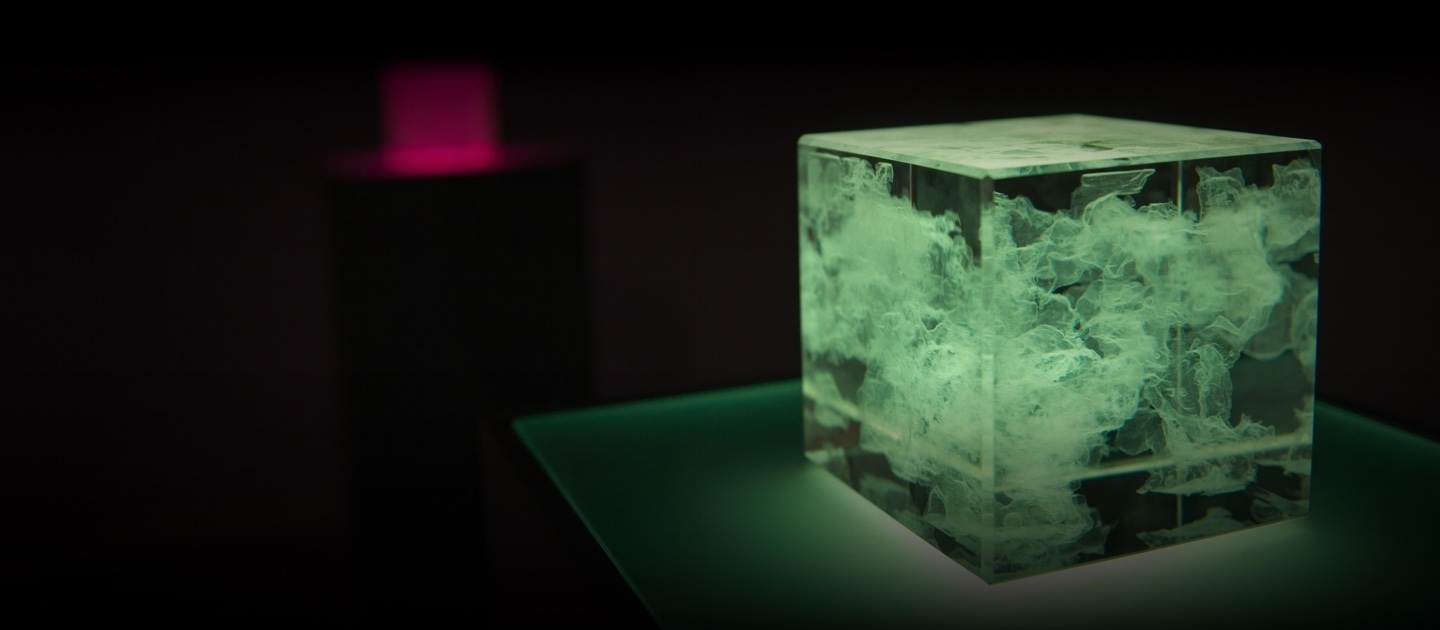
Art and Science: A Firm Commitment to Interdisciplinarity
Exploring nanotechnology and neurology is unusual from an art and design point of view. But for the ArTeCiH Contest, that is the goal: to cross the boundaries between disciplines.
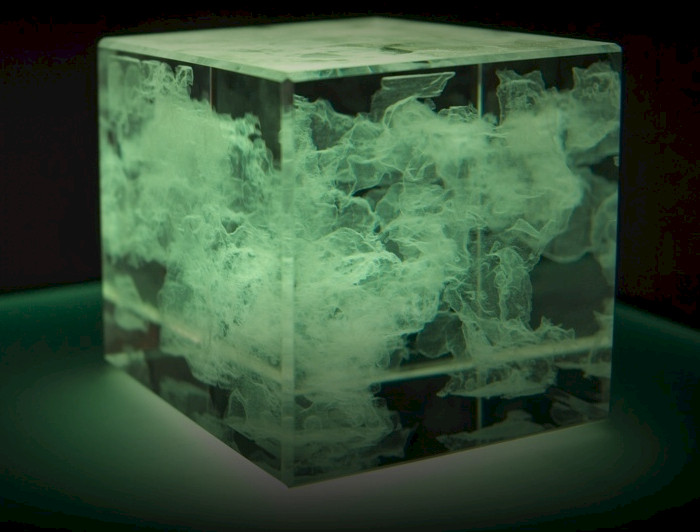
photo_camera Nanotechnology makes it possible to manipulate matter on an atomic level. In this project, they transformed a dense black rock into a transparent cube after combining science and art.
Science and art are often seen as two opposite worlds, or at least very distant.
The Arts & Technology, Science and Humanities Competition (ArTeCiH) goal is to explore the rifts and crossings to build bridges and even new worlds.
This competition is promoted by the Office for the Arts and Culture of the Office of the Vice President for Research. It aims to finance projects focused on generating knowledge from other disciplines' interdisciplinary work with the arts.
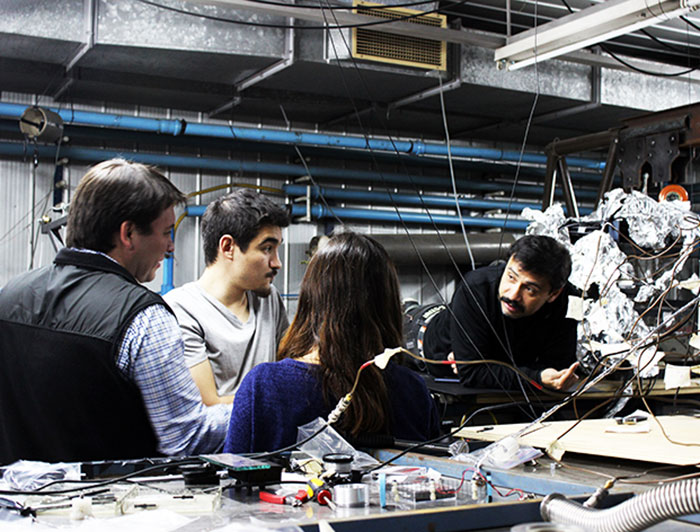
It is an invitation to artists and scientists to be inspired by mutual collaboration, challenging discipline boundaries. Developing new forms of creation and collaboration, with a broad, diverse, and provocative look at the link between the arts, technologies, sciences, and humanities.
Miryam Singer, Director of Arts and Culture, said:
"This competition promotes dialogue for the knowledge of other methodologies, other interesting objects that populate the world, and that is difficult to recognize when looked at from a different, isolated perspective. Or perhaps, the discovery that research and creation methodologies in all disciplines are very similar and that the boundaries are fictitious. The idea is to promote an integrated view of people's intervention globally and believe that "together, we can make it better."
In its five years of existence, 28 projects have been awarded, from different academic units, linking multiple disciplines and thematic areas.
Last November, the sixth version of the contest was finalized, the results of which will be known at the end of January 2021.
A Nano View of the World
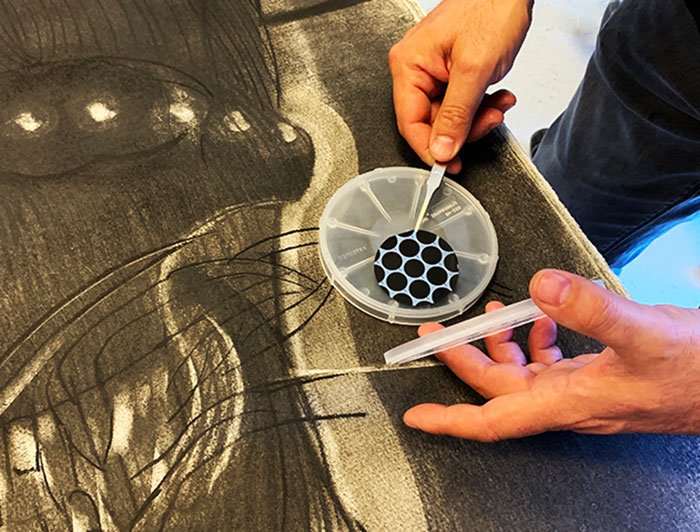
Can you imagine being able to see the atoms and molecules of things? Or even to be able to create products on a microscale?
Nanotechnology makes it possible to manipulate matter on an atomic level, that is to say, to manufacture devices with materials as small as one-millionth of a millimeter. The UC Nanotechnology and Advanced Materials Research Center (CIEN) research this objective.
Samuel Hevia is a physics professor and an expert in nanomaterials who represents the Faculty of Physics in CIEN. According to him, the idea of participating in an initiative that promotes the link between science and artistic creation came about because "we wanted to make our work visible and reach other audiences."
With this objective in mind, he approached the Faculty of Arts.
"As artists, we are always looking for new materials to make art, and nanomaterials were new to us. So we were motivated to participate in the project but as equals. It was not a matter of one subject and knowledge dominating over another. But rather entering into a process of mutual knowledge and exchange," explained Ricardo Fuentealba, art professor and painting expert.
Thus, a group of professors, artists, and scientists was formed, who would seek, working in pairs, to showcase nanotechnology through art. In other words, it was about producing a work of art from scientific research.
They also included two students from the Sociology and Anthropology programs, who would be in charge of recording the process and making an ethnographic account.
As you can imagine, the beginning was not easy.
A good part of the project was more focused on human relations than on artistic or scientific work:
- meeting,
- getting to know each other's field of study,
- learning the technical vocabulary of each discipline,
- exchanging views,
- generating links,
- and eliminating prejudices and stereotypes.
"We often think artists are the creative ones, but in science, there's also a unique creative process. In nanotechnology, you work with something you can't see. Imagine that!" said Ricardo Fuentealba.
"I was surprised to find out artists are very systematic and methodical," added Samuel Hevia, his scientific counterpart.
The approach process was slow.
"I didn't foresee how work would look like on the scale of nanotechnology," the art professor said.
"It is not easy to use the technologies and high-level equipment and apply it in art. There's a major learning curve, both in terms of technology and resources," added the physics professor.
Both professors slowly entered each other's world. Science and art merged, and ideas flowed.
As a result of these exchanges, they could get images of insects' internal structure through X-rays using a plasma reactor (a machine unique in the world).
The X-rays were then enlarged and transferred to the paper through smoke particles. Later they scan this smoke revealing its composed form of carbon nanoparticles through a scanning electron microscope.
Another attempt used black diorite, a rock that forms in the earth's depths at very high temperatures after the magma's slow cooling and solidification. In this case, instead of giving it an ornamental use, they take an X-ray microtomography. They scanned the rock in three dimensions observing each of its components separately at a microscopic scale.
They transformed the dense black rock into a transparent cube after combining science and art, revealing what is beyond the obvious.
Gold was another material observed under the microscope. Beyond the lens, its nanostructures, with different sizes and geometries, were no longer golden but instead took on shades ranging from red to bluish-purple.
Based on this investigation, they intervened the Kazimir Malevich's work (Eight Red Rectangles and Black Cross, 1915). Using pigments invisible to the human eye, they could change the gold and the work's color.
Seven works were exhibited in the Art Room of the National Museum of Fine Arts at the Plaza Vespucio Mall.
"The relationship with the public was one of closeness. People were surprised by the materials and wondered: Where is the gold?" said Ricardo Fuentealba.
"For me, the greatest result of this project was the change of perspective and the richness of new friendships. Before, I didn't go to the San Joaquin Campus. I found it very dull. Now I know there are people there I can visit. I wish we have more permanent spaces that encourage the crossing of points of view."
And Samuel Hevia concluded: "We're usually so focused on our work that we have little time and energy left to explore new areas. We must acknowledge this initiative arose from the university. There was an institutional effort to promote interdisciplinarity. In the future, I would like to continue exploring art, to reach other groups that we scientists don't usually approach, and disseminate this area seriously."
An Immersion into the Brain
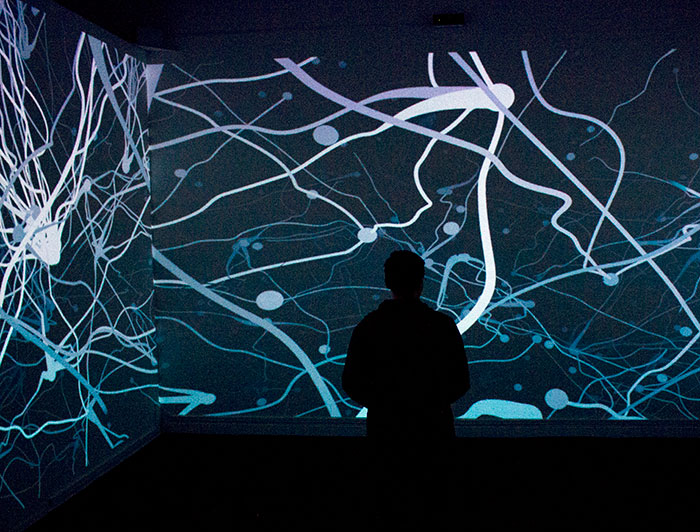
The brain never rests. But contrary to what one might think, its activity is more intense when in a "resting" state. When we do "nothing," some of its areas work at full power, activating the neural network by default. This work supports self-knowledge, autobiographical memories, social and emotional processes, and also creativity.
Visualizing brain activity during rest was precisely the goal of the project "DEFAULT: Visualizing the intrinsic dynamics of the brain."
"I have always liked biology. I took some courses while studying design, and I did my thesis in a laboratory on plant genetics," said Manuela Garretón, a faculty member of the School of Design. So when she saw the call for the ArTeCiH Competition, she asked her good friend, Tomás Ossandón, a biologist and expert in neurosciences, to work on something together.
"We wanted to explain what this brain state was about in less abstract terms. That was something I was researching about," said the scientist.
"I must understand what this resting state of the brain was. And I had to read a lot about it", said the designer.
A small team was then formed, with students and professionals. Each one contributed from their respective areas, performing collaborative work.
"The hardest part was to ground all this, to see how we were going to represent it. What the artistic proposal was going to be," recalled Manuela Garretón.
Finally, they captured this dialogue between design and neuroscience in two ways:
- an interactive web platform that narrates the performance of the default neural network
- an installation at the Anilla Room of the Museum of Contemporary Art.
The proposal focused on representing two brain states:
- Resting -when the default mode network is on.
- Task performing -when the brain responds to an external stimulus.
They could do all of this using data from an MRI exam.
"We had programmers who transformed the data into sound and images. Converting data into something visual in a physical space was quite a challenge," said the biologist.
The exhibition raised something quite innovative.
"It was like entering a brain. When people accessed the room, they faced three screens and were followed by a sensor. As they moved, the brain activity - the images and sounds - changed. But if another person came in, they were considered an external stimulus for the brain, and all activity ceased," she explained.
Around 32 thousand people visited the exhibition.
"The public was impressed by the aesthetics and took selfies to upload them to their social media. They interacted in the space as if it were a stage," said Manuela. "It was a fascinating experience," added Tomás.
They also held a workshop with experts in psychiatry, neuroscience, data visualization, and design. The whole event resulted in three papers that delved into different aspects.
"It was an excellent experience to be able to bring to life this different view. We were also able to involve two design students, who made their degree thesis on this project. And it was also very enriching to begin my doctorate in engineering," she said.
"Now, I see the images differently. My way of visualizing data was very stiff. Bridges between both disciplines are essential because a good visualization helps statistics being less complex and much more understandable," he added.
As Manuela Garretón concluded: "I appreciate having this space at the university and having support for this interdisciplinary view."


